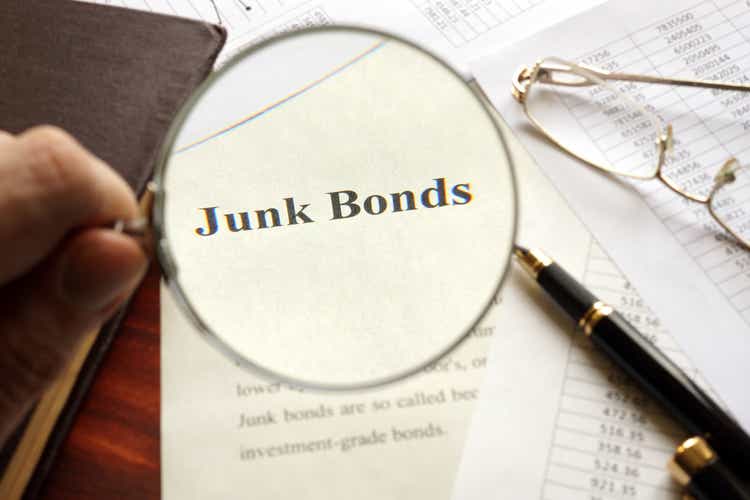
designer491 Strategy iShares Interest Rate Hedged High Yield Bond ETF ( NYSEARCA: HYGH ) started investing operations on 5/27/2014 and tracks the BlackRock Interest Rate Hedged High Yield Bond Index. It has a 12-month trailing yield of 9.63% and a 30-day SEC yield of 5.
99%. Distributions are paid monthly. HYGH is mostly invested in the high-yield bond benchmark iShares iBoxx $ High Yield Corporate Bond ETF ( HYG ) and uses derivatives to mitigate the interest rate risk.

The net expense ratio of 0.52% includes the fees of HYG, HYGH and a fee waiver. As described by iShares in the prospectus of the main holding HYG, eligible bonds must be U.
S. dollar-denominated, traded in the U.S.
and issued by companies based in developed markets with a sub-investment grade average rating. Other criteria include an outstanding value of at least $400 million, an original maturity of less than 15 years and at least 1.5 years to maturity (1 year for existing constituents).
Constituents are weighted based on market value, with a cap of 3% on each issuer. Additionally, according to its own prospectus , HYGH holds interest rate swap contracts with different maturities, selected and weighted " to hedge the portfolio's duration exposure (i.e.
, sensitivity to changes in interest rates) at key points on the yield curve ". Swap contracts to expire are rolled to further expiration dates on a monthly basis. The portfolio turnover rate in the most recent fiscal year was 5%.
Portfolio HYG represents 97.7% of asset value. The remaining 2.
3% of HYGH portfolio is in cash and derivatives. HYG has 1256 constituents. The top 10 issuers represent 11.
8% of asset value and the top name weighs 2.4%, so the portfolio is well-diversified and risks related to individual companies are low. The heaviest sectors in the portfolio are consumer cyclicals and communication services.
Sector breakdown in % (Chart: author; data: iShares) About 51% of asset value is invested in debt with a BB rating; therefore the fund is focused on less risky junk bonds (BBB is investment grade). Quality breakdown in % (Chart: author; data: iShares) About 47% of the assets have a maturity of between 3 and 5 years. The portfolio's weighted average maturity is 4.
05 years. Maturity breakdown in % (Chart: author; data: iShares) Performance HYGH has a total return of about 50% since its inception in 2014, outperforming HYG by almost 8%. Nonetheless, the gap in annualized return is well below 1%.
HYGH vs HYG total return (Seeking Alpha) The share price has lost over 15% (excluding distributions), as reported on the next chart. While it has been paying high distributions, the fund has suffered a loss in value. The decay is amplified by the cumulative inflation: about 32% since May 2014, based on CPI.
HYGH vs HYG, price return (Seeking Alpha) HYGH has significantly outperformed HYG in 2022 (almost 10% in one year), when the 10-year Treasury yield surged and the 10-year minus 2-year spread fell the most, as illustrated by the charts below. HYGH vs HYG, 2022 total return (Seeking Alpha) FRED data series GS10 (Federal Reserve Bank of St. Louis) FRED data series T10Y2Y (Federal Reserve Bank of St.
Louis) The annual sum of distributions has been quite irregular in value and trend, so HYGH is not really suitable for investors seeking a stable or growing income stream (distribution depends on the swap strategy performance). HYGH distribution history (Seeking Alpha) HYGH vs. competitors The next table compares characteristics of HYGH and the two other rate-hedged high-yield bond ETFs: HYGH is the largest and most liquid of these funds.
It has the highest 4-year average yield (by a short margin) and the highest 5-year dividend growth rate. The next chart plots total returns since its inception. HYGH is the best performer, although the three funds are in a narrow range.
HYGH vs. Competitors since 5/28/2014 (Seeking Alpha) Takeaway iShares Interest Rate Hedged High Yield Bond ETF ( HYGH ) is the largest, most liquid and best performing "junk bond" ETF hedged against interest rate variations. It has moderately underperformed the non-hedged underlying index when interest rates were staying in a range, then it widely outperformed when rates surged and the yield curve went inverted.
However, keep in mind the underlying assets are junk bonds, which I have already rated as unattractive in other ETF reviews, due to a chronic decay in value and distributions. Hedging an unattractive asset category is unlikely to make it a winner in the long run. Many high yield ETFs and closed-end funds suffer from capital and distribution decay.
However, decay can be avoided or mitigated by rotational strategies, instead of using funds as long-term investments. I designed a 5-factor ranking system in 2016 and monitored its performance during several years, before sharing the eight best ranked CEFs with my Investing Group members. Get started with a two-week free trial now.
Fred Piard, PhD. is a quantitative analyst and IT professional with over 30 years of experience working in technology. He is the author of three books and has been investing in data-driven systematic strategies since 2010.
Analyst’s Disclosure: I/we have no stock, option or similar derivative position in any of the companies mentioned, and no plans to initiate any such positions within the next 72 hours. I wrote this article myself, and it expresses my own opinions. I am not receiving compensation for it (other than from Seeking Alpha).
I have no business relationship with any company whose stock is mentioned in this article. Seeking Alpha's Disclosure: Past performance is no guarantee of future results. No recommendation or advice is being given as to whether any investment is suitable for a particular investor.
Any views or opinions expressed above may not reflect those of Seeking Alpha as a whole. Seeking Alpha is not a licensed securities dealer, broker or US investment adviser or investment bank. Our analysts are third party authors that include both professional investors and individual investors who may not be licensed or certified by any institute or regulatory body.
.














